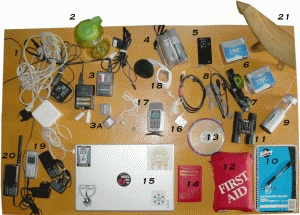February 24, 2011
Summary
The emergence of spreading news via mobile devices has become the latest in further improving the ever quickening pace of dissemination. Briggs offers examples of how mobile devices have been used to break news, and why they have had such an impact. With devices like the iPhone, news has now become a nearly instant process.
Key Terms
- Mobile Journalism– reporting done via a mobile device (including video, audio, picture, and text)
- Gearhead- journalists who are always out reporting, sometimes every day; they use multimedia to publish their stories, and are always using the latest in technology.
- Light packer- journalists who occasionally do reporting immediately from the field
Here, as seen in the link above, is a picture of some traditional equipment you may encounter when dealing with a MoJo:

Can't quite fit into the pocket...
Mobile journalism has become another means for those attempting to make a name for themselves as a journalist.
 No Comments » |
No Comments » |  Briggs |
Briggs |  Permalink
Permalink
 Posted by Brad Clark
Posted by Brad Clark
February 24, 2011
Summary
The significant rise of microblogging is discussed in detail in the fourth chapter, explaining how journalists moved from blogging to using microblogs, such as Twitter, to publish their news. In this new format, Briggs explains, journalists became more closely connected with other journalists and with their readers.
Why Twitter? It’s easier to follow someone and their news by a 140 character system than it is looking at the much longer blogs.
Key Terms:
- Microblogging- blogging on a smaller scale (think Twitter).
- DM- Direct message capability used on Twitter.
Many people think of ridiculous quotes by celebrities or Facebook style news feeds when they think of Twitter. This is, however, up to how you use Twitter, and who you follow.
Professional journalists aren’t going to be posting about what they had for lunch, or what kept them from sleeping last night; they take Twitter as seriously as they will any other platform now used for dissemination of news.
 No Comments » |
No Comments » |  Briggs |
Briggs |  Permalink
Permalink
 Posted by Brad Clark
Posted by Brad Clark
February 15, 2011
Summary
The third chapter deals with new types of reporting methods and platforms that are more relevant and efficient in today’s fast-paced world. Innovative ideas — such as open-source reporting and crowdsourcing – are explained to offer journalists improved credibility and resourcing.
Key Terms
- Pro-am Journalism- an extremely unfiltered form, this movement offers everyone interested an opportunity at journalism.
- Open-source reporting- gathering news in a transparent way, displaying your sources easily to the public.
- Crowdsourcing- idea of using a large number of sources to provide info for a story.
People outside of mainstream social media are now more important than ever to keeping the media from making mistakes and in providing more accurate news.
The idea of Pro-am journalism is important and helpful to the spreading of news today, and it allows new journalists more opportunities for success.
But this does not mean that, because you can be your own publisher, you can just put anything online. Be reliable and accurate, professionalism means responsibility.
 No Comments » |
No Comments » |  Briggs |
Briggs |  Permalink
Permalink
 Posted by Brad Clark
Posted by Brad Clark
February 15, 2011
Summary
The second chapter, “Advanced Blogging,” deals with basic blogging terms and techniques. Constant activity on your blog, with consistent posts and updating are stressed as essential for successful blogging. Keeping a good relationship with readers and knowing new and current terms will help new bloggers become acquainted with the whole blogging process.
Key Terms
- Trackback- mechanism that allows bloggers to inform others when they make a link to their material
- Blogroll- collection of links generally seen in the sidebar
- Moblog- blogging from a mobile device
Customize your blog to make it unique and attractive
- Don’t fall into the trap of being comfortable with a generic looking theme
- Stand out!
 No Comments » |
No Comments » |  Briggs |
Briggs |  Permalink
Permalink
 Posted by Brad Clark
Posted by Brad Clark
February 15, 2011
Summary
Chapter one introduces basic concepts and tools necessary for online journalism. From definitions of basic Internet terminology to more journalism specific key terms, Briggs lays out an easy introductory chapter for newbies. He also shares a few ideas that more experienced online writers will learn from, like OPML files.
Key Terms
- OPML file- outline processor markup language that allows easy exporting of feeds
- RSS- Really Simple Syndication, structures mass consumption of information for ease and organization
Subscribe to feeds! You can view much more information on the web than you think, with the help of RSS.
Be conscious of the size of files you share or send to viewers or recipients of your emails.
Firefox is a unique browser, try out its various tools!
 No Comments » |
No Comments » |  Briggs |
Briggs |  Permalink
Permalink
 Posted by Brad Clark
Posted by Brad Clark




 Posted by Brad Clark
Posted by Brad Clark